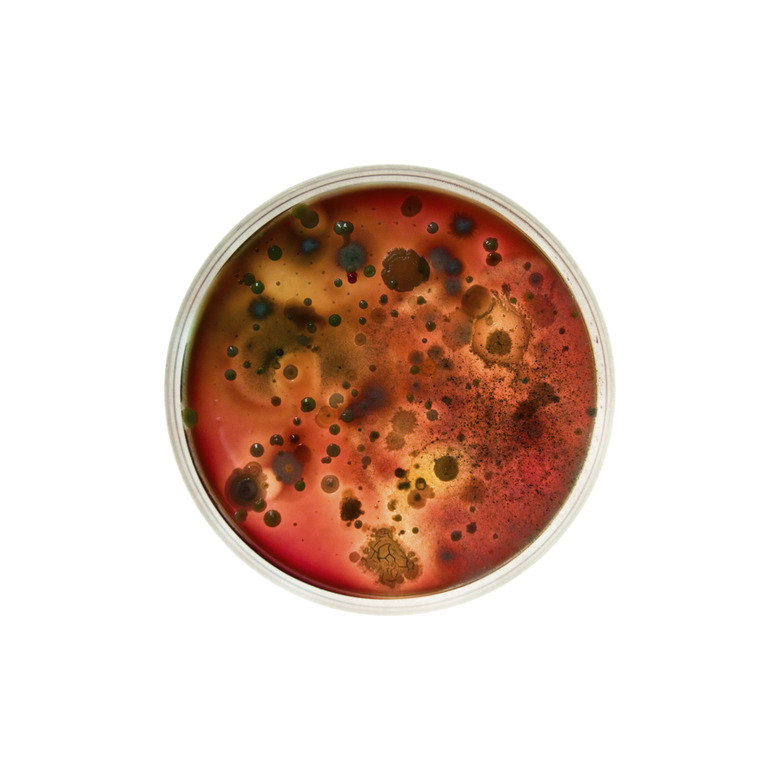How To Measure The Zone Of Inhibition
Bacteria are some of the most abundant organisms on Earth. Scientists estimate that there are over one trillion different species of bacteria, amounting to over five million trillion trillion (yes, that's two separate trillions) individuals on the planet.
Out of all those bacteria, though, less than 1 percent cause disease in humans. Those diseases can range from stomach upset, as you can get from a mild infection, to serious and fatal illnesses like the bubonic plague (caused by the Yersinia pestis bacteria) that killed 50 million people in the 14th century.
That's why the discovery of antibiotics, which are medications that eliminate bacteria, has saved so many lives. The trouble with bacteria is that they adapt and evolve very quickly, which leads to antibiotic-resistant strains of bacteria becoming increasingly common. Measuring the zone of inhibition for a strain of bacteria can tell scientists and physicians whether it is resistant to an antibiotic.
Antibiotics and How They Work
Antibiotics and How They Work
Antibiotics are medications that kill bacteria. They work by targeting and resulting in the death of bacterial cells while leaving your human cells alone. Each antibiotic works in a slightly different way by targeting bacteria-specific structures and signaling to eliminate them.
For example, penicillin (one of the most famous antibiotics) interferes with bacterial cell walls, which leads to them not functioning properly and, thus, dying. Medications that work like this are called beta-lactam antibiotics.
Macrolide antibiotics target bacterial ribosomes. This prevents bacteria from synthesizing proteins, which means that the bacteria cannot survive. A common example is erythromycin, an antibiotic that's used to treat a variety of infections including bronchitis and a number of skin infections.
Quinolone antibiotics are another common type of antibiotic that work by interfering with bacterial DNA.
Antibiotic-Resistance Testing
Antibiotic-Resistance Testing
After the initial discovery of antibiotics in the 1920s, scientists quickly realized that bacteria were evolving to be resistant to the medications. Many scientists then attempted to create methods that allowed them to test how susceptible bacterial strains were to antibiotics to understand what they were dealing with, so to speak.
The initial tests involved serial dilutions of bacterial broth spread onto plates with varying concentrations of antibiotic to determine susceptibility. This method took a long time, however.
The Kirby-Bauer Test
The Kirby-Bauer Test
That's where the Kirby-Bauer test comes in. This method was standardized by microbiologists W. M. M. Kirby and A. W. Bauer. Their test takes pure bacterial culture and streaks it onto an agar plate. Then, a small disk infused with antibiotics (appropriately called an antibiotic disk) is placed onto the agar plate. Various disks with different antibiotics are placed around the plate, and the bacteria are left to incubate for a certain amount of time.
Once the disk is placed onto the plate, the antibiotics will start to diffuse out. If the bacteria being studied is sensitive to the antibiotic, then no bacteria will grow close to the disk because it will be killed by the medication.
But as you move farther away from the antibiotic disk, the concentration of the antibiotic will decrease. At a certain distance from the disk, you'll start to see bacterial growth again because the antibiotic concentration is too low to affect the bacteria.
**The area around the antibiotic disk that has no bacterial growth is known as the zone of inhibition.** The zone of inhibition is a uniformly circular zone of no bacterial growth around the antibiotic disk. The larger this zone is, the more sensitive the bacteria is to that antibiotic. The smaller the zone is, the more resistant (and, thus, less sensitive) the bacteria is.
How to Measure the Zone of Inhibition
How to Measure the Zone of Inhibition
Besides naming this practice and protocol, scientists Kirby and Bauer also created standardized charts that used the diameter of the zone of inhibition to determine the bacteria's sensitivity or resistance to the bacteria.
These charts can be found here and use the bacterial species, the type of antibiotic used and the zone of inhibition diameter to determine whether the bacteria is resistant, intermediately sensitive or susceptible to that antibiotic.
**Note:** You always measure the zone of inhibition in terms of millimeters.
To measure the zone of inhibition, first place the plate on a non-reflective surface. Take a ruler or caliper that measures in millimeters and place the "0" in the center of the antibiotic disk. Measure from the center of the disk to the edge of area with zero growth. Take your measurement in millimeters.
This measures the radius of the zone of inhibition. Multiply that by two in order to get the diameter.
You can also measure directly across the zone of inhibition from edge to edge crossing through the center of the antibiotic disk to directly measure the diameter instead of measuring the radius.
References
- History Today: The Black Death: The Greatest Catastrophe Ever
- MedLine Plus: Bacterial Infections
- New York Times: Earth May Be Home to a Trillion Species of Microbes
- BBC News: Planet Bacteria
- University of Utah: Genetic Science Learning Center: What Is an Antibiotic?
- American Society for Microbiology: Kirby-Bauer Disk Diffusion Susceptibility Test Protocol
- Biology Wise: What Does Zone of Inhibition Mean and How to Measure It
Cite This Article
MLA
Walsh, Elliot. "How To Measure The Zone Of Inhibition" sciencing.com, https://www.sciencing.com/measure-zone-inhibition-6570610/. 30 July 2019.
APA
Walsh, Elliot. (2019, July 30). How To Measure The Zone Of Inhibition. sciencing.com. Retrieved from https://www.sciencing.com/measure-zone-inhibition-6570610/
Chicago
Walsh, Elliot. How To Measure The Zone Of Inhibition last modified March 24, 2022. https://www.sciencing.com/measure-zone-inhibition-6570610/
